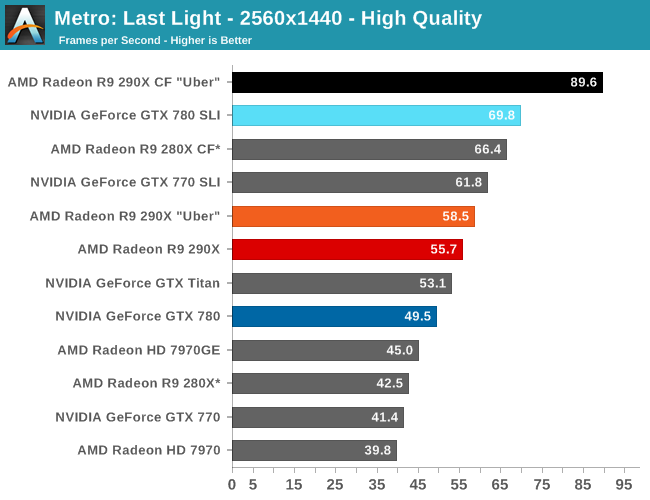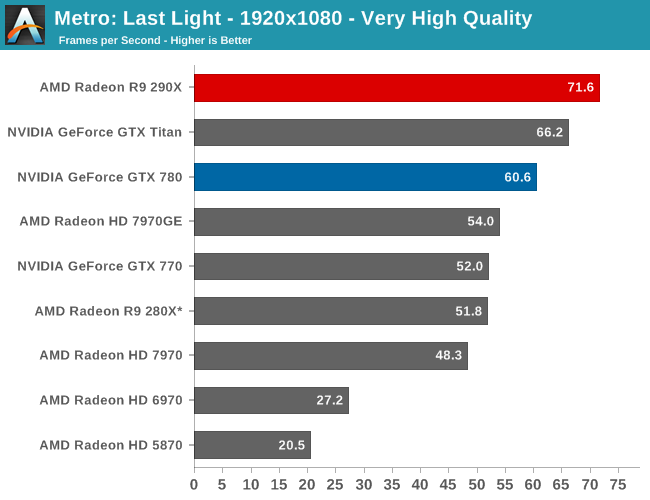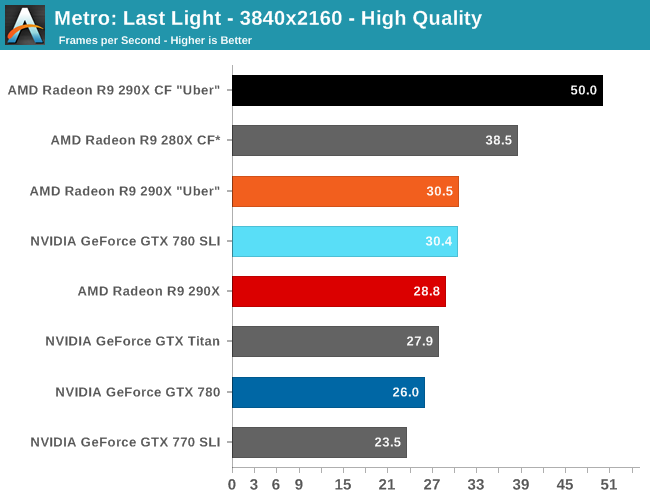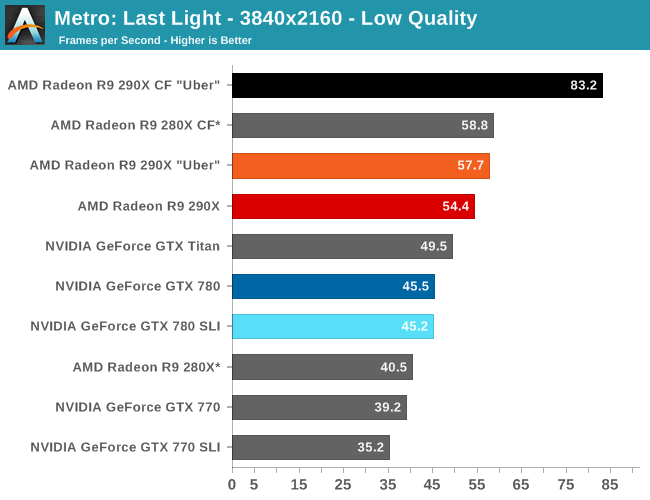The AMD Radeon R9 290X Review
by Ryan Smith on October 24, 2013 12:01 AM EST- Posted in
- GPUs
- AMD
- Radeon
- Hawaii
- Radeon 200
Metro: Last Light
As always, kicking off our look at performance is 4A Games’ latest entry in their Metro series of subterranean shooters, Metro: Last Light. The original Metro: 2033 was a graphically punishing game for its time and Metro: Last Light is in its own right too. On the other hand it scales well with resolution and quality settings, so it’s still playable on lower end hardware.


For the bulk of our analysis we’re going to be focusing on our 2560x1440 results, as monitors at this resolution will be what we expect the 290X to be primarily used with. A single 290X may have the horsepower to drive 4K in at least some situations, but given the current costs of 4K monitors that’s going to be a much different usage scenario.
With that said, for focusing on 4K on most games we’ve thrown in results both at a high quality setting, and a lower quality setting that makes it practical to run at 4K off of a single card. Given current monitor prices it won’t make a ton of sense to try to go with reduced quality settings just to save $550 – and consequently we may not keep the lower quality benchmarks around for future articles – but for the purposes of looking at a new GPU it’s useful to be able to look at single-GPU performance at framerates that are actually playable.
With that said, starting off with Metro at 2560 the 290X hits the ground running on our first benchmark. At 55fps it’s just a bit shy of hitting that 60fps average we love to cling to, but among all of our single-GPU cards it is the fastest, beating even the traditional powerhouse that is GTX Titan. Consequently the performance difference between 290X and GTX 780 (290X’s real competition) is even greater, with the 290X outpacing the GTX 780 by 13%, all the while being $100 cheaper. As we’ll see these results are a bit better than the overall average, but all told we’re not too far off. For as fast as GTX 780 is, 290X is going to be appreciably (if not significantly) faster.
290X also does well for itself compared to the Tahiti based 280X. At 2560 the 290X’s performance advantage stands at 31%, which as we alluded to earlier is greater than the increase in die size, offering solid proof that AMD has improved their performance per mm2 of silicon despite the fact that they’re still on the same 28nm manufacturing process. That 31% does come at a price increase of 83% however, which although normal for this price segment serves as a reminder that the performance increases offered by the fastest video cards with the biggest GPUs do not come cheaply.
Meanwhile for one final AMD comparison, let’s quickly look at the 290X in uber mode. As the 290X is unable to sustain the power/heat workload of a 1000MHz Hawaii GPU for an extended period of time, at its stock (quiet settings) it has to pull back on performance in order to meet reasonable operational parameters. Uber mode on the other hand represents what 290X and the Hawaii can do when fully unleashed; the noise costs won’t be pretty (as we’ll see), but in the process it builds on 290X’s existing leads and increases them by another 5%. And that’s really going to be one of the central narratives for 290X once semi-custom and fully-custom cards come online: Despite being a fully enabled part, 290X does not give us everything Hawaii is truly capable of.


Moving on, let’s talk about multi-GPU setups and 4K. Metro is a solid reminder that not every game scales similarly across different GPUs, and for that matter that not every game is going to significantly benefit from multi-GPU setups. Metro for its part isn’t particularly hospitable to multi-GPU cards, with the best setup scaling by only 53% at 2560. This is better than some games that won’t scale at all, but it won’t be as good as those games that see a near-100% performance improvement. Which consequently is also why we dropped Metro as a power benchmark, as this level of scaling is a poor showcase for the power/temp/noise characteristics of a pair of video cards under full load.
The real story here of course is that it’s another strong showing for AMD at both 2560 and 4K. At 2560 the 290X CF sees better performance scaling than the GTX 780 SLI – 53% versus 41% – further extending the 290X’s lead. Bumping the resolution up to 4K makes things even more lopsided in AMD’s favor, as at this point the NVIDIA cards essentially fail to scale (picking up just 17%) while the 290X sees an even greater scaling factor of 63%. As such for those few who can afford to seriously chase 4K gaming, the 290X is the only viable option in this scenario. And at 50fps average for 4K at high quality, 4K gaming at reasonable (though not maximum) quality settings is in fact attainable when it comes to Metro.
Meanwhile for single-GPU configurations at 4K, 4K is viable, but only at Metro’s lowest quality levels. This will be the first of many games where such a thing is possible, and the first of many games where going up to 4K in this manner further improves on AMD’s lead at 4K. Again, we’re not of the opinion that 4K at these low quality settings is a good way to play games, but it does provide some insight and validationg into AMD’s claims that their hardware is better suited for 4K gaming.










396 Comments
View All Comments
kyuu - Friday, October 25, 2013 - link
I agree. Ignore at all the complainers; it's great to have the benchmark data available without having to wait for all the rest of the article to be complete. Those who don't want anything at all until it's 100% done can always just come back later.AnotherGuy - Friday, October 25, 2013 - link
What a beastzodiacsoulmate - Friday, October 25, 2013 - link
Donno, all the geforce cards looks like sh!t in this review, and 280x/7970 290x looks like haven's god...but my 6990 7970 never really make me happier than my gtx 670 system...
well, whatever
TheJian - Friday, October 25, 2013 - link
While we have a great card here, it appears it doesn't always beat 780, and gets toppled consistently by Titan in OTHER games:http://www.techpowerup.com/reviews/AMD/R9_290X/24....
World of Warcraft (spanked again all resolutions by both 780/titan even at 5760x1080)
Splinter Cell Blacklist (smacked by 780 even, of course titan)
StarCraft 2 (by both 780/titan, even 5760x1080)
Titan adds more victories (780 also depending on res, remember 98.75% of us run 1920x1200 or less):
Skyrim (all res, titan victory at techpowerup) Ooops, 780 wins all res but 1600p also skyrim.
Assassins creed3, COD Black Ops2, Diablo3, FarCry3 (though uber ekes a victory at 1600p, reg gets beat handily in fc3, however hardocp shows 780 & titan winning apples-apples min & avg, techspot shows loss to 780/titan also in fc3)
Hardocp & guru3d both show Bioshock infinite, Crysis 3 (titan 10% faster all res) and BF3 winning on Titan. Hardocp also show in apples-apples Tombraider and MetroLL winning on titan.
http://www.guru3d.com/articles_pages/radeon_r9_290...
http://hardocp.com/article/2013/10/23/amd_radeon_r...
http://techreport.com/review/25509/amd-radeon-r9-2...
Guild wars 2 at techreport win for both 780/titan big also (both over 12%).
Also tweaktown shows lost planet 2 loss to the lowly 770, let alone 780/titan.
I guess there's a reason why most of these quite popular games are NOT tested here :)
So while it's a great card, again not overwhelming and quite the loser depending on what you play. In UBER mode as compared above I wouldn't even want the card (heat, noise, watts loser). Down it to regular and there are far more losses than I'm listing above to 780 and titan especially. Considering the overclocks from all sites, you are pretty much getting almost everything in uber mode (sites have hit 6-12% max for OCing, I think that means they'll be shipping uber as OC cards, not much more). So NV just needs to kick up 780TI which should knock out almost all 290x uber wins, and just make the wins they already have even worse, thus keeping $620-650 price. Also drop 780 to $500-550 (they do have great games now 3 AAA worth $100 or more on it).
Looking at 1080p here (a res 98.75% of us play at 1920x1200 or lower remember that), 780 does pretty well already even at anandtech. Most people playing above this have 2 cards or more. While you can jockey your settings around all day per game to play above 1920x1200, you won't be MAXING much stuff out at 1600p with any single card. It's just not going to happen until maybe 20nm (big maybe). Most of us don't have large monitors YET or 1600p+ and I'm guessing all new purchases will be looking at gsync monitors now anyway. Very few of us will fork over $550 and have the cash for a new 1440p/1600p monitor ALSO. So a good portion of us would buy this card and still be 1920x1200 or lower until we have another $550-700 for a good 1440/1600p monitor (and I say $550+ since I don't believe in these korean junk no-namers and the cheapest 1440p newegg itself sells is $550 acer). Do you have $1100 in your pocket? Making that kind of monitor investment right now I wait out Gsync no matter what. If they get it AMD compatible before 20nm maxwell hits, maybe AMD gets my money for a card. Otherwise Gsync wins hands down for NV for me. I have no interest in anything but a Gsync monitor at this point and a card that works with it.
Guru3D OC: 1075/6000
Hardwarecanucks OC: 1115/5684
Hardwareheaven OC: 1100/5500
PCPerspective OC: 1100/5000
TweakTown OC: 1065/5252
TechpowerUp OC: 1125/6300
Techspot OC: 1090/6400
Bit-tech OC: 1120/5600
Left off direct links to these sites regarding OCing but I'm sure you can all figure out how to get there (don't want post flagged as spam with too many links).
b3nzint - Friday, October 25, 2013 - link
"So NV just needs to kick up 780TI which should knock out almost all 290x uber wins, and just make the wins they already have even worse, thus keeping $620-650 price. Also drop 780 to $500-550"we're talking about titan killer here.
titan vs titan killer, at res 3840, at high or ultra :
coh2 - 30%
metro - 30%
bio - (10%) but win 3% at medium
bf3 - 15%
crysis 3 - tie
crysis - 10
totalwar - tie
hitman - 20%
grid 2 - 10%+
2816 sp, 64rop, 176tmu, 4gb 512bit. 780 or 780ti won't stand a chance. this is titan killer dude wake up. only then then we're talking CF, SLi and res 5760. But for single card i go for this titan killer. good luck with gsync, im not gave up my dell u2711 yet.
just4U - Friday, October 25, 2013 - link
Well.. you have to put this in context. Those guys gave it their editor's choice award and a overall score of 9.3 They summed it up with this.."
The real highlight of AMD's R9 290X is certainly the price. What has been rumored to cost around $700 (and got people excited at that price), will actually retail for $549! $549 is an amazing price for this card, making it the price/performance king in the high-end segment. NVIDIA's $1000 GTX Titan is completely irrelevant now, even the GTX 780 with its $625 price will be a tough sale."
theuglyman0war - Thursday, October 31, 2013 - link
the flagship gtx *80 $msrp has been $499 for every upgrade I have ever made. After waiting out the 104 fer the 110 chip only to have the insult of the previous 780 pricing meant I will be holding off to see if everything returns to normal with Maxwell. Kind of depressing when others are excited for $550? As far as I know the market still dictates pricing and my price iz $499 if AMD is offering up decent competition to keep the market healthy and respectful.ToTTenTranz - Friday, October 25, 2013 - link
How isn't this viral?nader21007 - Friday, October 25, 2013 - link
Radeon R9 290X received Tom’s Hardware’s Elite award—the first time a graphics card has received this honor. Nvidia: Why?Wiseman: Because it Outperformed a card that is nearly double it's price (your Titan).
Do you hear me Nvidia? Please don't gouge consumers again.
Viva AMD.
doggghouse - Friday, October 25, 2013 - link
I don't think the Titan was ever considered to be a gamer's card... it was more like "prosumer" card for compute. But it was also marketed to people who build EXTREME! machines for maximum OC scores. The 780 was basically the gamer's card... it has 90-95% of the Titan's gaming capability, but for only $650 (still expensive).If you want to compare the R9 290X to the Titan, I would look at the compute benchmarks. And in that, it seems to be an apples to oranges comparison... AMD and nVIDIA seem to trade blows depending on the type of compute.
Compared to the 780, the 290X pretty much beats it hands down in performance. If I hadn't already purchased a 780 last month ($595 yay), I would consider the 290X... though I'd definitely wait for 3rd party cards with better heat solutions. A stock card on "Uber" setting is simply way too hot, and too loud!